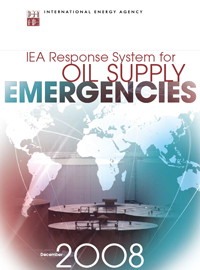Oil Supply Emergencies and the IEA Response System
The International Energy Agency (IEA) is the energy forum for 28 industrialised countries, founded in 1974 (see www.aip.com.au/pricing/iea.htm). IEA member country governments are committed to taking joint measures to meet oil supply emergencies. They also have agreed to share energy information, co-ordinate their energy policies and cooperate in the development of rational energy programmes. In Australia, the National Oil Supplies Emergency Committee (see below) fulfils the role of National Emergency Sharing Organisation, which is an ongoing requirement of Australia's membership of the International Energy Agency.
Emergency response to oil supply disruptions has remained a core mission of the IEA. The IEA emergency response mechanisms were set up under the 1974 Agreement on an International Energy Program (IEP Agreement). The IEP Agreement requires IEA member countries to hold oil stocks equivalent to at least 90 days of net oil imports and – in the event of a major oil supply disruption – to release stocks, restrain demand, switch to other fuels, increase domestic production or share available oil, if necessary. IEA collective response actions are designed to mitigate the negative impacts of sudden oil supply shortages by making additional oil available to the global market through a combination of emergency response measures, which include both increasing supply and reducing demand. Although supply shortages may bring about rising prices, prices are not a trigger for a collective response action, as these can be caused by other factors and the goal of the response action is to offset an actual physical shortage, not react to price movements.
For more information on the IEA decision-making process leading to an IEA collective action, the measures available, how this is implemented, and the historical background of major oil supply disruptions and the IEA response to them, see the IEA report.
